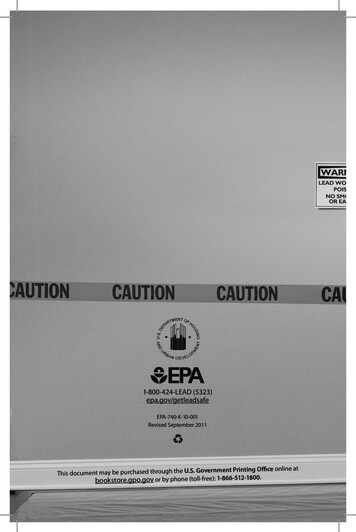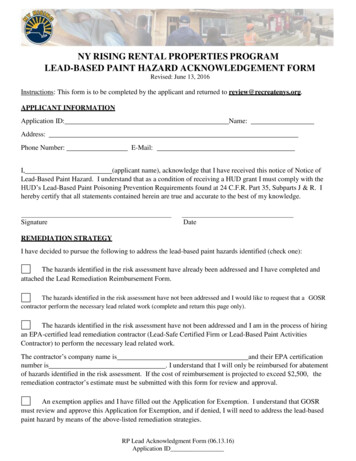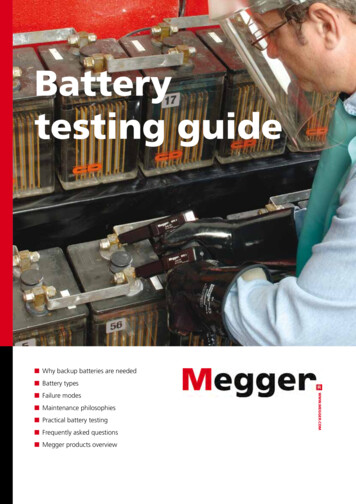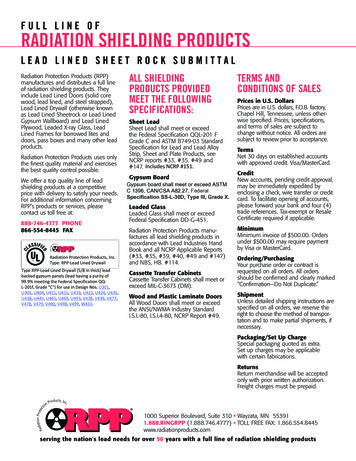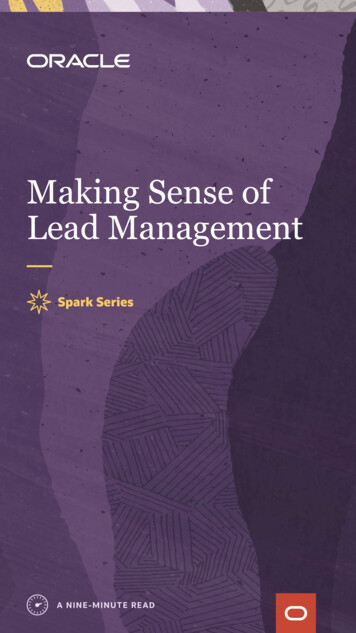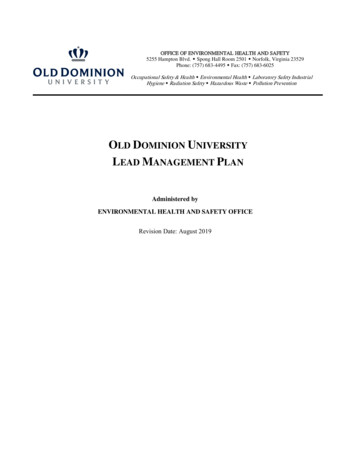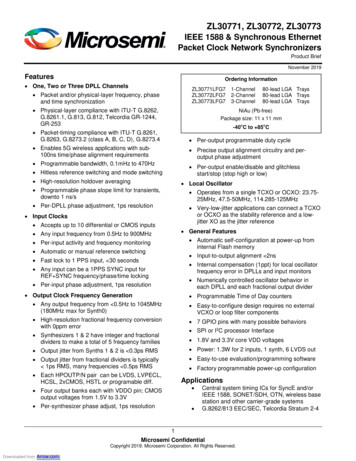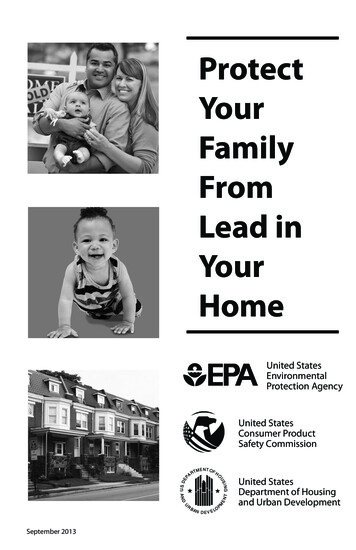
Transcription
ProtectYourFamilyFromLead inYourHomeUnited StatesEnvironmentalProtection AgencyUnited StatesConsumer ProductSafety CommissionUnited StatesDepartment of Housingand Urban DevelopmentSeptSeptember 2013
Are You Planning to Buy or Rent a Home BuiltBefore 1978?Did you know that many homes built before 1978 have lead-basedpaint? Lead from paint, chips, and dust can pose serious healthhazards.Read this entire brochure to learn: How lead gets into the bodyAbout health effects of leadWhat you can do to protect your familyWhere to go for more informationBefore renting or buying a pre-1978 home or apartment, federallaw requires: Sellers must disclose known information on lead-based paint or leadbased paint hazards before selling a house. Real estate sales contracts must include a specific warning statementabout lead-based paint. Buyers have up to 10 days to check for lead. Landlords must disclose known information on lead-based paintand lead-based paint hazards before leases take effect. Leases mustinclude a specific warning statement about lead-based paint.If undertaking renovations, repairs, or painting (RRP) projects inyour pre-1978 home or apartment: Read EPA’s pamphlet, The Lead-Safe Certified Guide to Renovate Right,to learn about the lead-safe work practices that contractors arerequired to follow when working in your home (see page 12).
Simple Steps to Protect Your Familyfrom Lead HazardsIf you think your home has lead-based paint: Don’t try to remove lead-based paint yourself. Always keep painted surfaces in good condition to minimizedeterioration. Get your home checked for lead hazards. Find a certifiedinspector or risk assessor at epa.gov/lead. Talk to your landlord about fixing surfaces with peeling orchipping paint. Regularly clean floors, window sills, and other surfaces. Take precautions to avoid exposure to lead dust whenremodeling. When renovating, repairing, or painting, hire only EPA- or stateapproved Lead-Safe certified renovation firms. Before buying, renting, or renovating your home, have itchecked for lead-based paint. Consult your health care provider about testing your childrenfor lead. Your pediatrician can check for lead with a simpleblood test. Wash children’s hands, bottles, pacifiers, and toys often. Make sure children avoid fatty (or high fat) foods and eatnutritious meals high in iron and calcium. Remove shoes or wipe soil off shoes before entering yourhouse.1
Lead Gets into the Body in Many WaysAdults and children can get lead into their bodies if they: Breathe in lead dust (especially during activities such as renovations,repairs, or painting that disturb painted surfaces). Swallow lead dust that has settled on food, food preparation surfaces,and other places. Eat paint chips or soil that contains lead.Lead is especially dangerous to children under the age of 6. At this age, children’s brainsand nervous systems aremore sensitive to thedamaging effects of lead. Children’s growing bodiesabsorb more lead. Babies and young childrenoften put their handsand other objects in theirmouths. These objects canhave lead dust on them.Women of childbearing age should know that lead is dangerous toa developing fetus. Women with a high lead level in their system before or duringpregnancy risk exposing the fetus to lead through the placentaduring fetal development.2
Health Effects of LeadLead affects the body in many ways. It is important to know thateven exposure to low levels of lead can severely harm children.In children, exposure to lead can cause: Nervous system and kidney damage Learning disabilities, attention deficitdisorder, and decreased intelligence Speech, language, and behaviorproblems Poor muscle coordination Decreased muscle and bone growth Hearing damageWhile low-lead exposure is most common,exposure to high amounts of lead can havedevastating effects on children, includingseizures, unconsciousness, and, in some cases, death.Although children are especially susceptible to lead exposure, lead canbe dangerous for adults, too.In adults, exposure to lead can cause: Harm to a developing fetus Increased chance of high blood pressure during pregnancy Fertility problems (in men and women) High blood pressure Digestive problems Nerve disorders Memory and concentration problems3 Muscle and joint pain
Check Your Family for LeadGet your children and home tested if you think your home haslead.Children’s blood lead levels tend to increase rapidly from 6 to 12months of age, and tend to peak at 18 to 24 months of age.Consult your doctor for advice on testing your children. A simple bloodtest can detect lead. Blood lead tests are usually recommended for: Children at ages 1 and 2 Children or other family members who have been exposed to highlevels of lead Children who should be tested under your state or local healthscreening planYour doctor can explain what the test results mean and if moretesting will be needed.4
Where Lead-Based Paint Is FoundIn general, the older your home or childcare facility, the more likely ithas lead-based paint.1Many homes, including private, federally-assisted, federallyowned housing, and childcare facilities built before 1978 havelead-based paint. In 1978, the federal government banned consumeruses of lead-containing paint.2Learn how to determine if paint is lead-based paint on page 7.Lead can be found: In homes and childcare facilities in the city, country, or suburbs, In private and public single-family homes and apartments, On surfaces inside and outside of the house, and In soil around a home. (Soil can pick up lead from exterior paint orother sources, such as past use of leaded gas in cars.)Learn more about where lead is found at epa.gov/lead.51“Lead-based paint” is currently defined by the federal government as paint withlead levels greater than or equal to 1.0 milligram per square centimeter (mg/cm), ormore than 0.5% by weight.2“Lead-containing paint” is currently defined by the federal government as lead in newdried paint in excess of 90 parts per million (ppm) by weight.
Identifying Lead-Based Paint and Lead-Based PaintHazardsDeteriorating lead-based paint (peeling, chipping, chalking,cracking, or damaged paint) is a hazard and needs immediateattention. Lead-based paint may also be a hazard when found onsurfaces that children can chew or that get a lot of wear and tear, suchas: On windows and window sills Doors and door frames Stairs, railings, banisters, and porchesLead-based paint is usually not a hazard if it is in good conditionand if it is not on an impact or friction surface like a window.Lead dust can form when lead-based paint is scraped, sanded, orheated. Lead dust also forms when painted surfaces containinglead bump or rub together. Lead paint chips and dust can get onsurfaces and objects that people touch. Settled lead dust can reenterthe air when the home is vacuumed or swept, or when people walkthrough it. EPA currently defines the following levels of lead in dust ashazardous: 40 micrograms per square foot (μg/ft2) and higher for floors,including carpeted floors 250 μg/ft2 and higher for interior window sillsLead in soil can be a hazard when children play in bare soil or whenpeople bring soil into the house on their shoes. EPA currently definesthe following levels of lead in soil as hazardous: 400 parts per million (ppm) and higher in play areas of bare soil 1,200 ppm (average) and higher in bare soil in the remainder of theyardRemember, lead from paint chips—which you can see—and leaddust—which you may not be able to see—both can be hazards.The only way to find out if paint, dust, or soil lead hazards exist is totest for them. The next page describes how to do this.6
Checking Your Home for LeadYou can get your home tested for lead in several different ways: A lead-based paint inspection tells you if your home has leadbased paint and where it is located. It won’t tell you whether yourhome currently has lead hazards. A trained and certified testingprofessional, called a lead-based paintinspector, will conduct a paint inspectionusing methods, such as: Portable x-ray fluorescence (XRF) machine Lab tests of paint samples A risk assessment tells you if your homecurrently has any lead hazards from leadin paint, dust, or soil. It also tells you whatactions to take to address any hazards. Atrained and certified testing professional,called a risk assessor, will: Sample paint that is deteriorated on doors, windows, floors, stairs,and walls Sample dust near painted surfaces and sample bare soil in theyard Get lab tests of paint, dust, and soil samples A combination inspection and risk assessment tells you if your homehas any lead-based paint and if your home has any lead hazards, andwhere both are located.Be sure to read the report provided to you after your inspection or riskassessment is completed, and ask questions about anything you do notunderstand.7
Checking Your Home for Lead, continuedIn preparing for renovation, repair, or painting work in a pre-1978home, Lead-Safe Certified renovators (see page 12) may: Take paint chip samples to determine if lead-based paint ispresent in the area planned for renovation and send them to anEPA-recognized lead lab for analysis. In housing receiving federalassistance, the person collecting these samples must be a certifiedlead-based paint inspector or risk assessor Use EPA-recognized tests kits to determine if lead-based paint isabsent (but not in housing receiving federal assistance) Presume that lead-based paint is present and use lead-safe workpracticesThere are state and federal programs in place to ensure that testing isdone safely, reliably, and effectively. Contact your state or local agencyfor more information, visit epa.gov/lead, or call 1-800-424-LEAD(5323) for a list of contacts in your area.33Hearing- or speech-challenged individuals may access this number through TTY bycalling the Federal Relay Service at 1-800-877-8399.8
What You Can Do Now to Protect Your FamilyIf you suspect that your house has lead-based paint hazards, youcan take some immediate steps to reduce your family’s risk: If you rent, notify your landlord of peeling or chipping paint. Keep painted surfaces clean and free of dust. Clean floors, windowframes, window sills, and other surfaces weekly. Use a mop or spongewith warm water and a general all-purpose cleaner. (Remember:never mix ammonia and bleach products together because they canform a dangerous gas.) Carefully clean up paint chips immediately without creating dust. Thoroughly rinse sponges and mop heads often during cleaning ofdirty or dusty areas, and again afterward. Wash your hands and your children’s hands often, especially beforethey eat and before nap time and bed time. Keep play areas clean. Wash bottles, pacifiers, toys, and stuffedanimals regularly. Keep children from chewing window sills or other painted surfaces, oreating soil. When renovating, repairing, or painting, hire only EPA- or stateapproved Lead-Safe Certified renovation firms (see page 12). Clean or remove shoes before entering your home to avoid trackingin lead from soil. Make sure children avoid fatty (or high fat) foods and eat nutritiousmeals high in iron and calcium. Children with good diets absorb lesslead.9
Reducing Lead HazardsDisturbing lead-based paint orremoving lead improperly canincrease the hazard to your family byspreading even more lead dust aroundthe house. In addition to day-to-day cleaningand good nutrition, you cantemporarily reduce lead-based painthazards by taking actions, such asrepairing damaged painted surfacesand planting grass to cover leadcontaminated soil. These actions arenot permanent solutions and will needongoing attention. You can minimize exposure to leadwhen renovating, repairing, or painting by hiring an EPA- or statecertified renovator who is trained in the use of lead-safe workpractices. If you are a do-it-yourselfer, learn how to use lead–safework practices in your home. To remove lead hazards permanently, you should hire a certified leadabatement contractor. Abatement (or permanent hazard elimination)methods include removing, sealing, or enclosing lead-based paintwith special materials. Just painting over the hazard with regularpaint is not permanent control.Always use a certified contractor who is trained to address leadhazards safely. Hire a Lead-Safe Certified firm (see page 12) to perform renovation,repair, or painting (RRP) projects that disturb painted surfaces. To correct lead hazards permanently, hire a certified lead abatementprofessional. This will ensure your contractor knows how to worksafely and has the proper equipment to clean up thoroughly.Certified contractors will employ qualified workers and follow strictsafety rules as set by their state or by the federal government.10
Reducing Lead Hazards, continuedIf your home has had lead abatement work done or if the housing isreceiving federal assistance, once the work is completed, dust cleanupactivities must be conducted until clearance testing indicates that leaddust levels are below the following levels: 40 micrograms per square foot (μg/ft2) for floors, including carpetedfloors 250 μg/ft2 for interior windows sills 400 μg/ft2 for window troughsFor help in locating certified lead abatement professionals in your area,call your state or local agency (see pages 14 and 15), or visitepa.gov/lead, or call 1-800-424-LEAD.11
Renovating, Remodeling, or Repairing (RRP) a Homewith Lead-Based PaintIf you hire a contractor to conduct renovation, repair, or painting(RRP) projects in your pre-1978 home or childcare facility (such aspre-school and kindergarten), your contractor must: Be a Lead-Safe Certified firm approved by EPA or anEPA-authorized state program Use qualified trained individuals (Lead-SafeCertified renovators) who follow specific lead-safework practices to prevent lead contamination Provide a copy of EPA’s lead hazard informationdocument, The Lead-Safe Certified Guide toRenovate RightRRP contractors working in pre-1978 homes and childcare facilitiesmust follow lead-safe work practices that: Contain the work area. The area must be contained so that dust anddebris do not escape from the work area. Warning signs must be putup, and plastic or other impermeable material and tape must be used. Avoid renovation methods that generate large amounts oflead-contaminated dust. Some methods generate so much leadcontaminated dust that their use is prohibited. They are: Open-flame burning or torching Sanding, grinding, planing, needle gunning, or blasting withpower tools and equipment not equipped with a shroud andHEPA vacuum attachment and Using a heat gun at temperatures greater than 1100 F Clean up thoroughly. The work area should be cleaned up daily.When all the work is done, the area must be cleaned up using specialcleaning methods. Dispose of waste properly. Collect and seal waste in a heavy dutybag or sheeting. When transported, ensure that waste is contained toprevent release of dust and debris.To learn more about EPA’s requirements for RRP projects visitepa.gov/getleadsafe, or read The Lead-Safe Certified Guide toRenovate Right.12
Other Sources of LeadWhile paint, dust, and soil are the most common sources of lead,other lead sources also exist: Drinking water. Your home might have plumbing with lead or leadsolder. You cannot see, smell, or taste lead, and boiling your water willnot get rid of lead. If you think your plumbing might contain lead: Use only cold water for drinking and cooking. Run water for 15 to 30 seconds before drinking it, especially ifyou have not used your water for a few hours.Call your local health department or water supplier to find outabout testing your water, or visit epa.gov/lead for EPA’s lead indrinking water information. Lead smelters or other industries that release lead into the air. Your job. If you work with lead, you could bring it home on your bodyor clothes. Shower and change clothes before coming home. Launderyour work clothes separately from the rest of your family’s clothes. Hobbies that use lead, such as making pottery or stained glass,or refinishing furniture. Call your local health department forinformation about hobbies that may use lead. Old toys and furniture may have been painted with lead-containingpaint. Older toys and other children’s products may have parts thatcontain lead.4 Food and liquids cooked or stored in lead crystal or lead-glazedpottery or porcelain may contain lead. Folk remedies, such as “greta” and “azarcon,” used to treat an upsetstomach.413In 1978, the federal government banned toys, other children’s products, and furniturewith lead-containing paint (16 CFR 1303). In 2008, the federal government bannedlead in most children’s products. The federal government currently bans lead inexcess of 100 ppm by weight in most children’s products (76 FR 44463).
For More InformationThe National Lead Information CenterLearn how to protect children from lead poisoning and get otherinformation about lead hazards on the Web at epa.gov/lead andhud.gov/lead, or call 1-800-424-LEAD (5323).EPA’s Safe Drinking Water HotlineFor information about lead in drinking water, call 1-800-426-4791, orvisit epa.gov/lead for information about lead in drinking water.Consumer Product Safety Commission (CPSC) HotlineFor information on lead in toys and other consumer products, or toreport an unsafe consumer product or a product-related injury, call1-800-638-2772, or visit CPSC’s website at cpsc.gov orsaferproducts.gov.State and Local Health and Environmental AgenciesSome states, tribes, and cities have their own rules related to leadbased paint. Check with your local agency to see which laws applyto you. Most agencies can also provide information on finding a leadabatement firm in your area, and on possible sources of financial aidfor reducing lead hazards. Receive up-to-date address and phoneinformation for your state or local contacts on the Web at epa.gov/lead,or contact the National Lead Information Center at 1-800-424-LEAD.Hearing- or speech-challenged individuals may access any of thephone numbers in this brochure through TTY by calling the tollfree Federal Relay Service at 1-800-877-8339.14
U. S. Environmental Protection Agency (EPA)Regional OfficesThe mission of EPA is to protect human health and the environment.Your Regional EPA Office can provide further information regardingregulations and lead protection programs.Region 1 (Connecticut, Massachusetts, Maine,New Hampshire, Rhode Island, Vermont)Region 6 (Arkansas, Louisiana, New Mexico,Oklahoma, Texas, and 66 Tribes)Regional Lead ContactU.S. EPA Region 15 Post Office Square, Suite 100, OES 05-4Boston, MA 02109-3912(888) 372-7341Regional Lead ContactU.S. EPA Region 61445 Ross Avenue, 12th FloorDallas, TX 75202-2733(214) 665-2704Region 2 (New Jersey, New York, Puerto Rico,Virgin Islands)Region 7 (Iowa, Kansas, Missouri, Nebraska)Regional Lead ContactU.S. EPA Region 22890 Woodbridge AvenueBuilding 205, Mail Stop 225Edison, NJ 08837-3679(732) 321-6671Region 3 (Delaware, Maryland, Pennsylvania,Virginia, DC, West Virginia)Regional Lead ContactU.S. EPA Region 31650 Arch StreetPhiladelphia, PA 19103(215) 814-2088Region 4 (Alabama, Florida, Georgia,Kentucky, Mississippi, North Carolina, SouthCarolina, Tennessee)Regional Lead ContactU.S. EPA Region 4AFC Tower, 12th Floor, Air, Pesticides & Toxics61 Forsyth Street, SWAtlanta, GA 30303(404) 562-8998Region 5 (Illinois, Indiana, Michigan,Minnesota, Ohio, Wisconsin)Regional Lead ContactU.S. EPA Region 5 (DT-8J)77 West Jackson BoulevardChicago, IL 60604-3666(312) 886-783615Regional Lead ContactU.S. EPA Region 711201 Renner Blvd.WWPD/TOPELenexa, KS 66219(800) 223-0425Region 8 (Colorado, Montana, NorthDakota, South Dakota, Utah, Wyoming)Regional Lead ContactU.S. EPA Region 81595 Wynkoop St.Denver, CO 80202(303) 312-6966Region 9 (Arizona, California, Hawaii,Nevada)Regional Lead ContactU.S. EPA Region 9 (CMD-4-2)75 Hawthorne StreetSan Francisco, CA 94105(415) 947-4280Region 10 (Alaska, Idaho, Oregon,Washington)Regional Lead ContactU.S. EPA Region 10Solid Waste & Toxics Unit (WCM-128)1200 Sixth Avenue, Suite 900Seattle, WA 98101(206) 553-1200
Consumer Product Safety Commission (CPSC)The CPSC protects the public against unreasonable risk of injuryfrom consumer products through education, safety standardsactivities, and enforcement. Contact CPSC for further informationregarding consumer product safety and regulations.CPSC4330 East West HighwayBethesda, MD 20814-44211-800-638-2772cpsc.gov or saferproducts.govU. S. Department of Housing and UrbanDevelopment (HUD)HUD’s mission is to create strong, sustainable, inclusivecommunities and quality affordable homes for all. ContactHUD’s Office of Healthy Homes and Lead Hazard Control forfurther information regarding the Lead Safe Housing Rule, whichprotects families in pre-1978 assisted housing, and for the leadhazard control and research grant programs.HUD451 Seventh Street, SW, Room 8236Washington, DC 20410-3000(202) 402-7698hud.gov/offices/lead/This document is in the public domain. It may be produced by an individual or organization withoutpermission. Information provided in this booklet is based upon current scientific and technicalunderstanding of the issues presented and is reflective of the jurisdictional boundaries established bythe statutes governing the co-authoring agencies. Following the advice given will not necessarilyprovide complete protection in all situations or against all health hazards that can be caused by leadexposure.U. S. EPA Washington DC 20460U. S. CPSC Bethesda MD 20814U. S. HUD Washington DC 20410EPA-747-K-12-001September 201316
IMPORTANT!Lead From Paint, Dust, and Soil in andAround Your Home Can Be Dangerous ifNot Managed Properly Children under 6 years old are most at risk for leadpoisoning in your home. Lead exposure can harm young children and babies evenbefore they are born. Homes, schools, and child care facilities built before 1978are likely to contain lead-based paint. Even children who seem healthy may have dangerouslevels of lead in their bodies. Disturbing surfaces with lead-based paint or removinglead-based paint improperly can increase the danger toyour family. People can get lead into their bodies by breathing orswallowing lead dust, or by eating soil or paint chipscontaining lead. People have many options for reducing lead hazards.Generally, lead-based paint that is in good condition is nota hazard (see page 10).
Get your children and home tested if you think your home has lead. Children's blood lead levels tend to increase rapidly from 6 to 12 months of age, and tend to peak at 18 to 24 months of age. Consult your doctor for advice on testing your children. A simple blood test can detect lead. Blood lead tests are usually recommended for:
